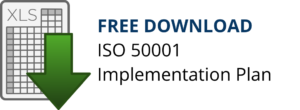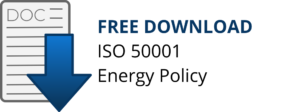Four years no nonconformities winning streak has ended. Shall I worry? Not at all. For the first time in a long time, I have to give credit to the external auditor for an extraordinary job during a two days visit.
My ISO 50001 implementation process has been a success – now it can be yours
Don’t take my word for it. Here is the extract from the audit report:
The organisation has developed an energy management system (EnMS) giving considerable effort to bringing this system in line with the ISO 50001:2011 standard and integrating elements from the ISO 14001 system ISO 9001 system where possible. But also, in considering how its development will support the strategic direction of the organisation in increasing profitability, and driving cost efficiencies.
Today I will share with you all insights from the Stage 1 Audit of the ISO 50001.
Plus you will get access to the following documents:
- ISO 50001 implementation plan
- Energy Policy
Follow these steps and make it Your success story
Let’s start with the positives. We have been recommended for the Stage 2 Audit, so it’s safe to say that our methodology is successful.
Here are the critical elements of the implementation process that have made it successful
- Implementation plan
Good, old-fashioned spreadsheet based plan. I have used this type of approach for years with 100% success rate. First time application for Energy Management System has proven to be no different.
Remember the KISS principle – Keep It Simple, Stupid
Feel free to download my complete implementation plan here.
- Training
We have spent virtually nothing on the external training.
We have built our competence using freely available online materials. There are plenty of articles, posts and videos. Proof? You are just reading one!
It would be unfair for me to recommend any specific websites or services. However, the accessibility to ISO related information has never been easier.
This approach scores high with auditors! Why? It shows the resourcefulness and proactivity. Something to keep in mind.
- Energy performance indicators
Be careful with the energy performance indicators as these are supposed to show improvement to the energy management.
Implementation of the EnMS is pointless if you cannot show the positive changes to the energy performance. This will stop you from getting ISO 50001 certification.
However, as long as you can show at least one positive trend, you are safe.
Example – your energy performance indicator EPV (Energy per volume) may be getting worst (lower number of customer orders while the cost of running the facility is fixed) but your actual energy usage has decreased compared to the same period last year.
Yes – we have made mistakes too
Implementation of any ISO standard brings challenges and obstacles. Our Stage 1 audit has highlighted few shortcomings.
I want you to avoid simple mistakes we’ve made.
- Energy Policy – religiously follow the requirements
Sounds simple but somehow we have missed one thing.
4.3 c) of the standard reads “includes a commitment to ensure the availability of information and the necessary resources to achieve objectives and targets”.
Considering the amount of work that has been put into the implementation of the ISO 50001 the commitment was quite evident. However, it must be included in the manual.
Here is the free, revised Energy Policy template you can download.
It’s based on the document approved by the Auditor.
- Energy review
Remember to include the forecast for future energy usage. Although we have provided an excellent analysis of current and past performance, the anticipated usage for the next year was not present.
Top tip – a forecast of the future energy usage does not have to be very accurate. As long as you provide the best estimate, this will satisfy the requirements of the standard.
- Energy baseline
I have to admit that this was a bit of surprise to us. The energy baseline must not be set in the current year but the year before.
Our Stage 1 Audit took place in November. Therefore the energy baseline set by us covered the period Jan – Oct 2018. Wrong! It should be the 2017 period. Something worth knowing.




2 Comments
Leave your reply.